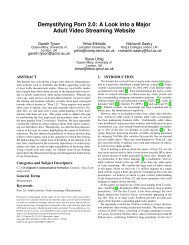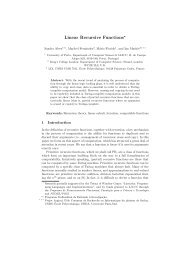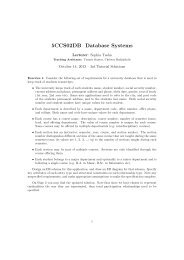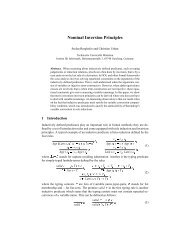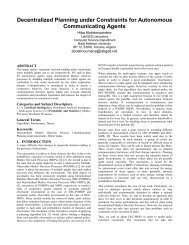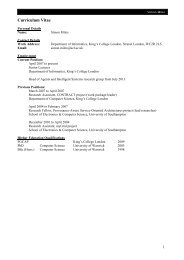Upgrade Report - Department of Informatics - King's College London
Upgrade Report - Department of Informatics - King's College London
Upgrade Report - Department of Informatics - King's College London
- No tags were found...
Create successful ePaper yourself
Turn your PDF publications into a flip-book with our unique Google optimized e-Paper software.
7 GRAPH GENERATION 24Figure 10: Implicit Graph Model. α = 1.25,N = 10000,c = 1.8We can observe that the out-degree distribution follows a power-law, as expected by definition. Thein-degree distribution approaches a log distribution but has some anomalies which may be a direct effect <strong>of</strong>the way we determine the target vertices <strong>of</strong> the model’s edges. The modularity Q = 0.6 which is significantlyhigher than expected however we currently consider this to be an artifact <strong>of</strong> the edge endpoint selectionin conjunction with the fact that there are several disconnected components within the graph. It is worthnoting however that the graph mainly consists <strong>of</strong> a single large component which in this case contains over99% <strong>of</strong> the vertices <strong>of</strong> the graph while the second largest component consists <strong>of</strong> only 8 vertices.7.5 Partitioned Preferential AttachmentThis model is essentially a combination <strong>of</strong> the well known preferential attachment model with an additionalelement <strong>of</strong> periodic partitioning <strong>of</strong> the graph. This partitioning may happen at random or fixed intervals andit intuitively simulates the cell reproduction procedure. When the graph being generated reaches a “criticalmass” s then we split it in two parts. The split is performed at random. We treat each partition as a newgraph and continue to add vertices to random partitions and attaching edges to each vertex preferentially.The preferential selection is based on the degrees <strong>of</strong> the vertices in the current partition. During the splitthe edges which have endpoints belonging to different components are maintained, which maintains theconnected nature <strong>of</strong> the graph.The resulting degree distribution from this generative process is seen in Figure 11



